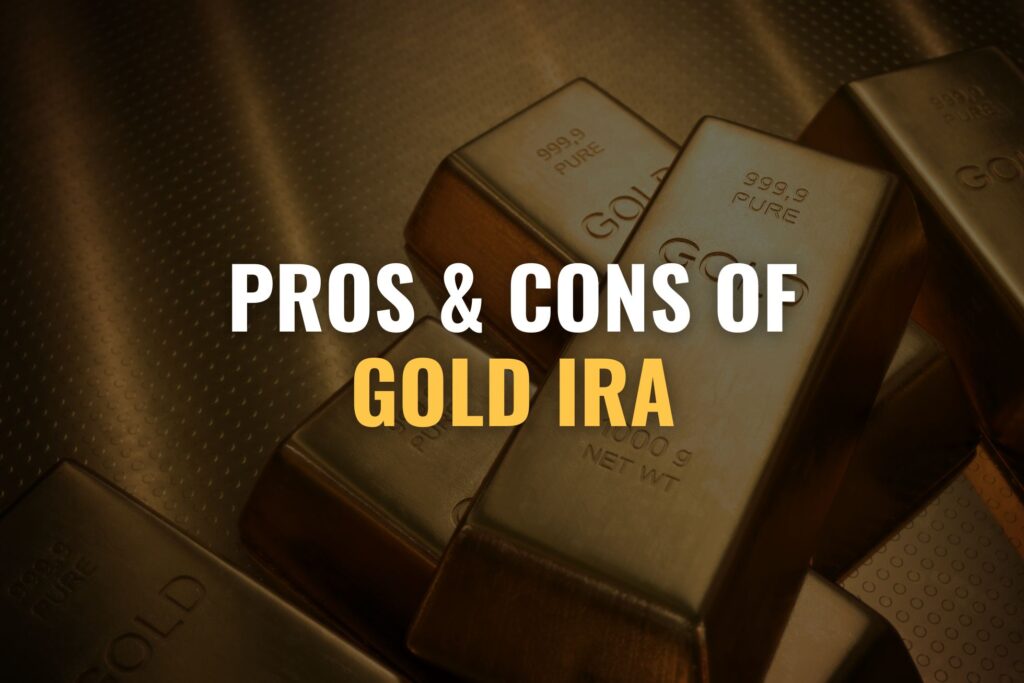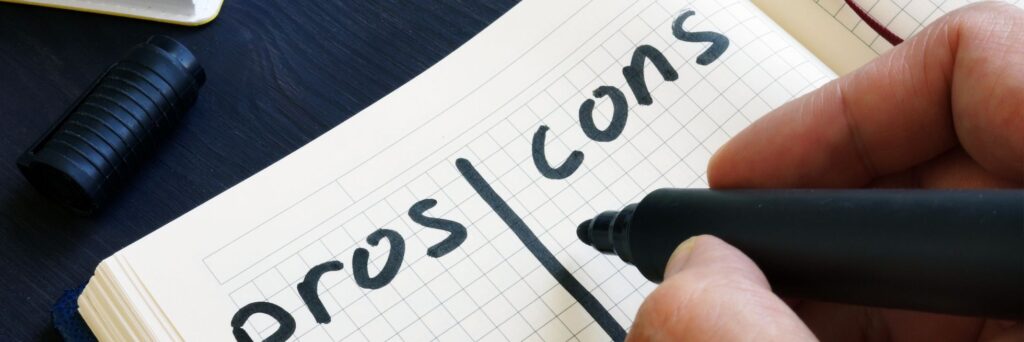What are the Pros and Cons of a Gold IRA?

Preparing for retirement is an important step in the life of every person. Regardless of your current financial success or the amount you set aside for the future, the worth of your savings will change over time. Large savings now may not guarantee financial security when you retire.
Many individuals choose retirement plans like IRAs to address this. A traditional IRA functions like a standard savings account, but a gold IRA is often preferred by those looking to include precious metals in their investments. This option helps protect the value of your savings, unlike paper currencies that can decline in unstable economies.
However, just because a gold IRA is widely chosen doesn’t mean it suits everyone. You must evaluate whether it aligns with your financial goals and needs. To assist you, we’ll review the advantages and disadvantages of a gold IRA. Let’s dive in!
Quick Overview of the Pros and Cons
Pros
- Adding gold to your retirement savings can spread out your investments. This mix helps balance riskier assets, like stocks, potentially making your portfolio more stable during market swings.
- Gold often holds its worth over long periods. It can act as a shield when inflation increases or when paper currencies lose value, helping preserve your savings’ purchasing power.
- A Gold IRA provides tax perks similar to standard IRAs. Depending on whether it’s a traditional or Roth IRA, you might enjoy tax-deferred growth or withdraw funds tax-free in retirement.
Cons
- Gold IRAs typically involve extra fees. These include charges for setting up the account, storing the physical gold, and paying a custodian to manage it. Such costs can reduce your overall gains.
- Selling physical gold may take more time and effort than selling stocks or bonds. This can be inconvenient if you need quick access to your money.
- Gold does not produce dividends or interest, unlike stocks or bonds. Your returns depend entirely on the gold’s price increasing, which may limit income potential during retirement.
How Does a Gold IRA Work?
A gold IRA, or Individual Retirement Account, closely resembles a standard IRA. Essentially, it acts as a savings vehicle where you can deposit funds and continue adding to them annually until you retire.
Once you reach retirement age, you can withdraw these funds in portions, known as Required Minimum Distributions (RMDs). The IRS calculates these withdrawals each year based on your IRA’s total value. While a gold IRA shares many similarities with a traditional IRA, the key distinction lies in the assets you can hold. A traditional IRA permits investments in stocks, bonds, and similar assets.
In contrast, a gold IRA, often called a precious metals IRA, allows you to invest in physical precious metals such as gold, silver, platinum, and palladium, typically in the form of coins, bars, or bullion. These metals often increase in value during economic downturns or stock market declines, making them a more secure choice for long-term investing.

It’s important to understand that a gold IRA is essentially a self-directed IRA that has stricter handling standards than other retirement accounts. To satisfy the IRS requirements, you have to set up the account through an IRS-approved custodian and ensure that only IRA-eligible precious metals are included.
What qualifies as IRA-eligible precious metals? These are metals that meet specific purity standards, including:
- Gold with a minimum purity of 99.5%
- Silver with a minimum purity of 99.9%
- Platinum with a minimum purity of 99.95%
- Palladium with a minimum purity of 99.95%
Pros of a Gold IRA
A gold IRA is a compelling choice for many planning their retirement. You might ask, “What makes it such a strong option?” The answer lies in the unique advantages of investing in gold, combined with the tax benefits a gold IRA companies. Let’s explore these benefits in detail.
Portfolio Diversification
One of the greatest strengths of a gold IRA is diversification. Smart investors avoid putting all their money into a single asset or company. Individual investments can be unpredictable, and a sudden drop in value could lead to significant losses. If you rely on one asset and it fails, you risk losing everything.
Gold offers a solution. As a tangible asset, it often remains stable when the stock market falters. By including gold in your portfolio, you reduce the impact of losses from other investments. This approach helps keep your finances secure, no matter how other assets perform.
Protection Against Inflation
With inflation steadily rising amid economic uncertainty, choosing assets that preserve your wealth is essential. Compared to other investment options, gold and precious metals have consistently held their value. In contrast, real estate, stocks, and paper currency have faced challenges in maintaining their worth.
This doesn’t mean you should pour all your funds into gold. However, because gold carries a lower risk of sharp declines, it’s an effective way to protect a portion of your savings for the future.
Opportunity for Growth
Gold has shown steady growth over the years. History offers several examples of its impressive gains. For instance, between 1971 and 1980, the price of gold soared from $35 per ounce to over $850 per ounce, a remarkable 2,000% increase for investors.
Another notable period was during the COVID-19 pandemic. In August 2020, gold reached a value of approximately $2,037 per ounce, up from about $1,500 earlier that year. These moments highlight how economic challenges can drive demand for gold, leading to significant price surges. As a result, gold stands out as a reliable long-term investment with strong growth potential.
Tax Benefits
Like other retirement accounts, a gold IRA offers valuable tax advantages. Here’s how it works: You invest pre-tax dollars in gold, which is held in your IRA. When you retire, you receive distributions from the account. The key benefit is that you’re taxed only once.
In typical investments, you pay income tax on your earnings and then capital gains tax when you withdraw funds. With a gold IRA, you avoid this double taxation. Depending on the type of gold IRA (Roth or traditional) you pay tax either when you contribute to the account or when you take withdrawals. This structure allows you to maximize your savings over time.

Cons of a Gold IRA
Having covered the benefits of a gold IRA, let’s now examine some key disadvantages of this widely chosen retirement investment.
Price Volatility
While gold often shows strong long-term growth, it’s not immune to fluctuations. Its value can rise significantly but also drop sharply. For example, gold prices may climb over a decade, yet experience several ups and downs within a single year. This volatility isn’t a major concern if you’re holding gold for the long haul in an IRA.
However, when you retire and need to convert your Required Minimum Distributions (RMDs) into cash, timing becomes critical. You might have to sell your gold at a lower price if the market dips, or wait for a price surge to get better returns. This uncertainty can affect the value you ultimately receive from your gold assets.
Storage and Additional Costs
Think a gold IRA only involves buying gold? Think again. This investment comes with several extra expenses. These include:
- A one-time fee to open the account (charged by the custodian or investment firm)
- Annual maintenance fees (charged by the custodian or investment firm)
- Yearly storage fees (charged by the depository storing your gold)
- Other potential fees, depending on the company you work with
These costs add up, making a gold IRA more suitable for those with substantial savings and steady income to cover them. Additionally, some firms set minimum investment requirements, limiting your ability to allocate smaller amounts to a gold IRA while managing these expenses.
Challenges with Liquidity
In a gold IRA, you don’t physically hold the gold, even after retirement. Your annual RMDs, determined by the IRS, dictate how much gold you can access each year. Selling or liquidating this distribution isn’t always straightforward, especially in urgent situations.
The process can be slow. After your RMD is calculated, the gold must be delivered to you, which takes time. Only then can you begin searching for buyers. This delay can be frustrating if you need quick access to funds, making gold less liquid than other investments.
No Dividend Income
Unlike stocks, which may pay regular dividends, gold generates no short-term profits. Its value depends entirely on market price changes, which aren’t guaranteed to be significant. While gold has the potential for long-term gains, there’s no certainty that its price will rise substantially during your investment period. This lack of periodic returns can be a drawback for those seeking steady income from their investments.
Assessing Your Financial Objectives
After reviewing the advantages and disadvantages of a gold IRA, the next step is to decide if this investment aligns with your retirement plans. How can you make this decision? By carefully evaluating your financial objectives and determining how a gold IRA fits into them. To define your specific goals, consider these key questions:
- What is my investment horizon? When will I need access to my funds?
- How much risk am I comfortable with? Can I handle fluctuating returns, and how often?
- What portion of my portfolio can I allocate to precious metals like gold?
- What kind of lifestyle do I envision in retirement, and which investments will support it?
- What will my retirement expenses look like? Can selling gold assets cover those costs effectively?
Answering these questions will help you clarify your retirement goals. If a gold IRA seems to match these objectives, it may be a suitable choice. If you’re unsure, consulting a financial advisor is a wise move. A professional can guide you in crafting a clear, tailored investment strategy.
How to Open a Gold IRA
If you’re convinced a gold IRA is right for you, the process to get started is straightforward. Below is a simple guide to setting up your gold IRA investment.
Step 1: Choose a Reputable Gold IRA Company
Begin by selecting a trusted gold investment company. Look for a company with a solid reputation, transparent fee structures, a wide range of investment options, and a dedicated team ready to assist you. Ensure the provider is approved by the IRS.
For recommendations, check out our discussion on top gold IRA companies for 2025. Some of the highly rated options include Goldco and Augusta Precious Metals.
Step 2: Fund Your Account
Next, you’ll need to deposit funds into your gold IRA. The funding options depend on the company you choose, but most allow transfers or rollovers from existing IRAs or 401(k) accounts. Your gold IRA provider will work directly with the administrator of your other retirement account to facilitate the process smoothly.
A gold IRA rollover must be completed within a 60-day timeframe, otherwise the distribution may be subject to taxes and penalties as per IRS regulations.
Step 3: Select Your Investments
Once your account is funded, you can choose which precious metals to invest in, based on the company’s offerings. After making your selections, the assets will be added to your account and securely stored in an IRS-approved third-party depository.
Conclusion
A gold IRA offers a compelling option for building a financially secure retirement. It combines the stability of gold ownership with attractive tax advantages. To maximize its benefits, ensure you follow IRS regulations to avoid penalties and fully enjoy the rewards of your investment. For more guidance, explore articles on leading gold IRA providers and detailed guides on gold IRA investing to kickstart your journey.
